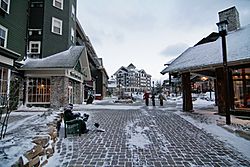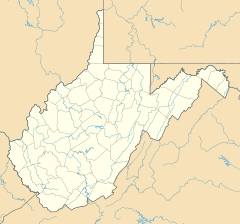Snowshoe, West Virginia facts for kids
Quick facts for kids
Snowshoe, West Virginia
|
||
|---|---|---|

The Village at Snowshoe Mountain
|
||
|
||
| Motto(s):
Forever Wild
|
||
| Country | United States | |
| State | West Virginia | |
| County | Pocahontas | |
| Founded | 1974 | |
| Elevation | 4,848 ft (1,478 m) | |
| Population
(2000)
|
||
| • Total | 163 [1] | |
| Time zone | UTC-5 (EST) | |
| • Summer (DST) | UTC-4 (EDT) | |
| ZIP Code |
26209
|
|
| Area code | 304 | |
| Exchange | 572 | |
| Website | snowshoemtn.com | |
Snowshoe is a special place in Pocahontas County, West Virginia, United States. It's known for the amazing Snowshoe Mountain ski resort. This area is nestled high in the Allegheny Mountains. It sits where two big mountain ridges, Cheat and Back Allegheny Mountains, meet.
Snowshoe is home to the second highest point in West Virginia. This spot is called Thorny Flat on Cheat Mountain. It reaches an elevation of 4,848 feet (1,478 meters) above sea level!
Snowshoe has cool areas for shops and fun. The main spot is The Village at Snowshoe. It's unique because it's at the very top of the mountain, not at the bottom. While Snowshoe is famous for winter sports, there's lots to do all year.
You can find:
- Awesome mountain biking trails
- A popular golf course
- Places for weddings and big events
- Many summer outdoor activities
- A Grand National Cross Country racing event
About 480,000 skiers visit Snowshoe every year. Most come from West Virginia and bigger cities nearby. These include places in the Mid-Atlantic and Southeast.
The Snowshoe Mountain property is huge! It covers about 10,950 acres (44.3 square kilometers). This includes resort areas, a nature conservation area, and lots of wild backcountry. The ski slopes themselves cover 244 acres (0.99 square kilometers). These slopes are divided into areas like Snowshoe Basin, Western Territory, and Silver Creek.
History of Snowshoe Mountain
This area was once part of a place called Slatyfork. From about 1905 to 1960, people used to cut down trees here. After that, the land was left alone.
Then, a dentist from North Carolina named Thomas "Doc" Brigham found the mountain. He thought it would be a perfect spot for a new ski resort. Doc Brigham had already opened other ski areas like Sugar Mountain and Beech Mountain. Snowshoe Mountain officially opened for skiing on December 13, 1974.
Snowshoe's Mountain Climate
Snowshoe is much cooler than lower areas nearby. In January, the average temperature is about 22.1°F (-5.5°C). In July, it's around 62.6°F (17.0°C).
The winter season usually lasts a bit more than 130 days each year. During spring, summer, and fall, Snowshoe hosts many sports, recreation, and cultural events.
Snowshoe has a humid continental climate. This means it has warm summers and cold, snowy winters.
Because Snowshoe is almost a mile high, its weather is like places much farther north. It's more like the tough winters of Northern New England than the milder climate of the Upland South. The mountains around Snowshoe form a special micro-climate. This means the weather here can be very different from nearby areas. Often, moisture from the Great Lakes gets pushed up by the mountains. This causes huge snowfalls! Snowshoe gets over 13 feet (4 meters) of natural snow each year on average.
| Climate data for Snowshoe, West Virginia (1991–2020 normals, extremes 1975–present) | |||||||||||||
|---|---|---|---|---|---|---|---|---|---|---|---|---|---|
| Month | Jan | Feb | Mar | Apr | May | Jun | Jul | Aug | Sep | Oct | Nov | Dec | Year |
| Record high °F (°C) | 57 (14) |
63 (17) |
76 (24) |
79 (26) |
82 (28) |
82 (28) |
87 (31) |
85 (29) |
79 (26) |
77 (25) |
70 (21) |
64 (18) |
87 (31) |
| Mean maximum °F (°C) | 50.8 (10.4) |
51.8 (11.0) |
60.2 (15.7) |
70.3 (21.3) |
74.1 (23.4) |
76.9 (24.9) |
77.8 (25.4) |
76.8 (24.9) |
74.8 (23.8) |
68.5 (20.3) |
60.1 (15.6) |
52.2 (11.2) |
79.1 (26.2) |
| Mean daily maximum °F (°C) | 29.8 (−1.2) |
31.8 (−0.1) |
38.9 (3.8) |
51.0 (10.6) |
59.7 (15.4) |
66.6 (19.2) |
69.8 (21.0) |
68.8 (20.4) |
63.5 (17.5) |
53.3 (11.8) |
42.0 (5.6) |
34.1 (1.2) |
50.8 (10.4) |
| Daily mean °F (°C) | 22.1 (−5.5) |
23.9 (−4.5) |
30.8 (−0.7) |
42.0 (5.6) |
51.4 (10.8) |
59.0 (15.0) |
62.6 (17.0) |
61.7 (16.5) |
56.3 (13.5) |
45.7 (7.6) |
34.6 (1.4) |
27.0 (−2.8) |
43.1 (6.2) |
| Mean daily minimum °F (°C) | 14.3 (−9.8) |
15.9 (−8.9) |
22.8 (−5.1) |
33.0 (0.6) |
43.2 (6.2) |
51.3 (10.7) |
55.4 (13.0) |
54.6 (12.6) |
49.1 (9.5) |
38.1 (3.4) |
27.2 (−2.7) |
19.8 (−6.8) |
35.4 (1.9) |
| Mean minimum °F (°C) | −7.6 (−22.0) |
−4.0 (−20.0) |
3.3 (−15.9) |
15.0 (−9.4) |
28.5 (−1.9) |
40.4 (4.7) |
47.8 (8.8) |
46.9 (8.3) |
35.8 (2.1) |
22.1 (−5.5) |
9.6 (−12.4) |
0.8 (−17.3) |
−10.3 (−23.5) |
| Record low °F (°C) | −36 (−38) |
−20 (−29) |
−8 (−22) |
1 (−17) |
16 (−9) |
29 (−2) |
36 (2) |
33 (1) |
25 (−4) |
11 (−12) |
−4 (−20) |
−26 (−32) |
−36 (−38) |
| Average precipitation inches (mm) | 6.06 (154) |
4.95 (126) |
5.97 (152) |
5.17 (131) |
5.84 (148) |
5.71 (145) |
4.87 (124) |
4.76 (121) |
4.42 (112) |
4.10 (104) |
4.47 (114) |
6.22 (158) |
62.54 (1,589) |
| Average snowfall inches (cm) | 35.5 (90) |
31.4 (80) |
27.2 (69) |
8.5 (22) |
0.8 (2.0) |
0.0 (0.0) |
0.0 (0.0) |
0.0 (0.0) |
0.0 (0.0) |
2.8 (7.1) |
9.7 (25) |
28.8 (73) |
144.7 (368) |
| Average precipitation days (≥ 0.01 in) | 23.6 | 19.4 | 19.8 | 17.2 | 18.4 | 17.7 | 17.6 | 17.3 | 14.8 | 15.1 | 16.4 | 21.0 | 218.3 |
| Average snowy days (≥ 0.1 in) | 12.3 | 10.7 | 8.4 | 3.3 | 0.7 | 0.0 | 0.0 | 0.0 | 0.0 | 1.4 | 4.7 | 9.3 | 50.8 |
| Source: NOAA | |||||||||||||



